We sincerely hope that you enjoy this article about 4 Beguiling Bats. Most unfortunately, many of these amazing mammals have long been misunderstood by humans. While some of them can pose a danger to humans, to be certain, most remain completely harmless. Further, some varieties can be considered highly beneficial. For example, in some parts of the world, some of these 4 Beguiling Bats may consume as many as 1,000 mosquitoes in a single night.
Pallid Bat
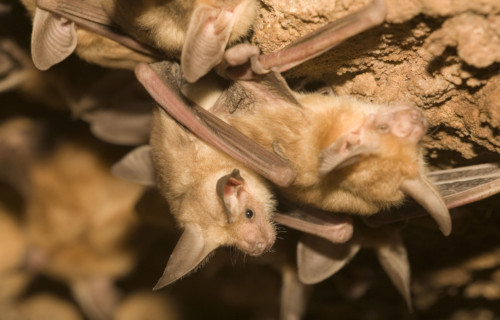
CCL: https://bit.ly/3bkr0Dw
Pallid Bat Facts
- First up in this article about 4 Beguiling Bats comes the remarkable species known simply as the Pallid Bat.
- Firstly, the distinctive term aptly serves as the common name for the species of bat with the bulky scientific name of Antrozous pallidus. Secondly, this surprising creature also holds a moderate claim to fame, at least in scientific circles.
- That holds true due to a claim that few species can make. That remains the fact that the mammal also presently remains the only species within its genus. It also bears a close relationship with another variety of bat, the Van Gelder’s bat.
- This amazing species also distinguishes itself from other bats in yet another, more important manner. That’s due to a rather startling evolutionary divergence. Quite amazingly, it does not always employ echolocation to locate its food.
- Although it does certainly have and use this ability, it also sometimes hunts in a different fashion. In this instance, the animal uses its large ears to locate its food. In this case, it employs them to locate prey, usually insects, on the ground.
- Quite fortunately, the fascinating Pallid Bat appears to continue to be be abundant throughout the entirety of its natural range. Due to this, the IUCN currently lists the animal as Least Concern on its Red List of Threatened Species.
- Nevertheless, the remarkable creature still faces several potential concerns regarding its future. That’s because, like many species, it faces the danger of habitat loss. However, it also must now deal with the threat of climate change.
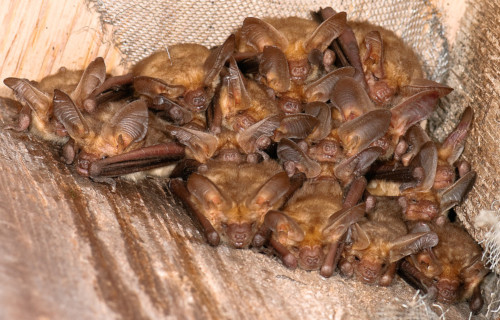
CCL: https://bit.ly/2UDM1lN
Pallid Bat Physical Description
Despite its other unique and distinctive characteristics, the fascinating Pallid Bat nevertheless remains a physical modest-sized species. But, it does remain unlike the vast majority of the other types of bats in the world in one particular regard.
That holds true because the fascinating species displays no noticeable degree of the trait of sexual dimorphism. As a result of the lack of this genetic trait, mature adults of both genders attain roughly the same average head-and-body length.
More precisely, this equals a measurement of about 2.4 – 3.35 in (6.0 – 8.5 cm). In addition, the over-sized tail may account for 1.4 – 2.25 in (3.5 – 5.7 cm) of this length. Further, this type of bat also achieves an average wingspan measuring roughly 15 – 16 in (38 – 40 cm).
Additionally, this remarkable animal develops a somewhat distinctive fur. To be more precise, this fur reportedly has a feel akin to that of soft wool. Furthermore, this pelage almost exclusively presents a highly uncommon two-tone color pattern.
That’s due to the fact that it appears as light brown to a cream color on the upper side of the small body. Meanwhile, the rest of the body diverges from this. In a moderately sharp contrast, the Pallid Bat presents a decidedly pale white color on the under side.
- Kingdom: Animalia
- Phylum: Chordata
- Class: Mammalia
- Order: Chiroptera
- Family: Vespertilionidae
- Genus: Antrozous
- Species: A. pallidus
Pallid Bat Distribution, Habitat, and Ecology
Most notably, the remarkable Pallid Bat inhabits a quite extensive habitat range compared to other varieties of bats. To the great surprise of many people, the truly remarkable small mammal appears throughout a large portion of the continent of North America.
More precisely, this bat lives in areas extending from British Columbia, in Canada, through the western United States, and as far as central Mexico. Also, for currently unknown reasons, one small population of the creature also currently resides in Cuba.
Regardless of its exact geographical location, however, the impressive mammal displays a marked preference for a specific habitat type. That consists mainly of desert or at least semi-arid regions within its native range. This is a trait shared by many related species.
In addition, although it roosts opportunistically, it most frequently prefers stony outcroppings. But it will also opportunistically roost in regions such as pine and oak forests, and even farmland. It also often has two roosts, one for day use and one for the night.
In another deviation from the patterns displayed by most bats, it does not mainly consume flying insects. It typically hunts its prey on the ground. Although it will take virtually any arthropod it finds, this typically consists of crickets, but sometimes even includes scorpions.
As a result, the diet of individual specimens of Pallid Bat varies somewhat. This occurs because it principally consumes various locally prevalent arthropods. In fact, this insectivore often consumes as much as half its body weight in prey every night.
Malaysian Flying Fox
Malaysian Flying Fox Facts
- Our next choice for inclusion among these 4 Beguiling Bats is the phenomenal species known as the Malaysian Flying Fox.
- The truly remarkable creature featured herein represents a truly phenomenal species of megabat endemic to Southeast Asia. In addition, the mammal also remains one of the largest known species of bat on earth.
- Further, the impressive creature also goes by alternate common names. These include such terms as the kalang, and the greater flying fox. Its scientific name, however, remains the somewhat difficult to pronounce Pteropus vampyrus.
- Like all fruit bats from the Old World, this remarkably impressive creature possesses a characteristic that surprises many people. To the great surprise of many individuals, the amazing animal lacks the ability to echolocate like other bats.
- However, given its great size, one particular fact remains encouraging to note, This holds true due to the fact that this astonishing species has an entirely herbivorous diet. Otherwise, its great size could pose a legitimate threat to livestock.
- But, most unfortunately, the population numbers of the fabulous Malaysian Flying Fox appear to be diminishing rapidly. Consequently, the IUCN currently lists the scientifically impressive animal as Near Threatened. This appears on its Red List.
- Climate change and habitat loss presently pose the greatest threats to its continued existence. Thankfully, several concerted conservation efforts remain underway. But, these unfortunately continue to be complicated by the actions of man.
Malaysian Flying Fox Physical Description
The Malaysian Flying Fox stands out from related species by virtue of its physical size. The enormous mammal represents one of the largest known species of bat on earth. In point of fact, it develops an impressive average wingspan measuring as much as 5 ft (1.5 m).
Much like many types of mammals, it displays a slight degree of sexual dimoirphism. In its case, this presents itself in terms of the nature of its fur. This holds true due to the fact that the fur of the males generally tends to be longer and thicker than that of the female.
This remarkable animal also attains an astonishing weight for its type of creature. Amazingly, mature adult specimens weigh an average of 2.4 lb (1.2 kg). As a result of this, it sometimes appears slow in flight. Nevertheless, it’s renowned for being highly maneuverable.
In a remarkable coincidence of evolution, the Malaysian Flying Fox also possesses a somewhat fox-like face. This coincidental resemblance serves as the origin of the common name. Much of the large body also has a covering of long, thick fur. This generally displays a reddish-brown color.
- Kingdom: Animalia
- Phylum: Chordata
- Class: Mammalia
- Order: Chiroptera
- Family: Pteopodidae
- Genus: Pteropus
- Species: P. vampyrus
Malaysian Flying Fox Distribution, Habitat, and Ecology
The sincerely amazing Malaysian Flying Fox known habitat range apparently covers a fairly large area of the world. This holds true due to the fact that this extends from the Malay Peninsula to the Philippines, Sumatra, Borneo, Java, and even Timor.
Additionally, it also appears to be comparatively adaptable in its habitat. As a result, it sometimes appears at elevations of as much as 4,490 ft (1,370 m). Furthermore, though it prefers the higher elevations, the mammal also inhabits lower regions when necessary.
Further, in some portions of its habitat range, this magnificent creature even lives in a most unusual range for its type of creature. This holds true since it even appears along coastlines. However, it does show a decided preference for areas further inland.
In point of fact, the marvelous bat most commonly lives in regions such as dense mangrove forest, primary forests, coconut groves, and even large fruit orchards. Also, the groupings in mangrove forest usually remain smaller than those in other areas.
But, the continually surprising Malaysian Flying Fox yet evolved another characteristic that amazes the casual observer. That’s the tendency of the fascinating mammal to often live in extremely large colonies. While many bats do, it takes this to another level.
This mammal comes together in groups perhaps more properly called super-groups. Some of these colonies have been known to number as many as 20,000 individuals. Finally, given its particular feeding habits, it exclusively consumes flowers, nectar, and various fruits.
Honduran White Bat
Honduran White Bat Facts
- Placing third in this compilation of 4 Beguiling Bats is the amazingly unique and distinctive Honduran White Bat.
- First of all, the highly descriptive term serves as one of the common names of a highly unique species of bat. The other, somewhat longer, accepted common name for this astonishing species is the Caribbean white tent-making bat.
- However, Ectophylla alba serves as the shorter, more pronounceable scientific name for the species. But, regardless of which name one uses to refer to the fabulous animal, this remains one of the most highly distinctive varieties of bat.
- Furthermore, this particular natural distinctiveness occurs due to its unusual coloring. Despite centuries of exploration, few such creatures are known to exist. In point of fact, experts currently know of only six varieties of white bat in existence.
- More than 1,300 species of bat exist throughout the world. Therefore, less than 0.5% of related creatures display this color pattern. In addition, it also stands out for yet another reason. It’s among the few types that modifies its environment for its use.
- In addition, a sad fact about the known population of the magnificent Honduran White Bat exists. Most unfortunately, this now appears to be diminishing rapidly. As a result, the IUCN now lists the fascinating animal as Near-Threatened.
- Further, this very lamentable status appears on the organization’s Red List of Threatened Species. It appears there due to its current situation. Quite sadly, the highly remarkable small mammal currently faces several threats to its continued existence.
- Finally, one of these pressing dangers continues to be the numerous human incursions into its natural habitat. However, the greatest threat to the continued existence of this remarkable species comes from ongoing climate change.
Honduran White Bat Physical Description
The Honduran White Bat easily qualifies as remarkable. But it does not earn that adjective due to its size. It actually ranks as a small bat. In fact, mature adults attain an average body length of around 2 in (5 cm). Its weight typically averages only about 0.2 oz (6 grams).
But, its other physical traits merit attention. While its fur develops as short, it’s also typically a bright white in color. Various shades of light gray do occasionally manifest themselves. Also, the nose is relatively over-sized, and the ears and nose show a bright amber in color.
The Honduran White Bat also displays another appealing color pattern. Portions of the legs appear amber in color. Males and females also remain of roughly equal size, with no apparent sexual dimorphism. Finally, in stark contrast to its fur, the wings are completely black in color.
- Kingdom: Animalia
- Phylum: Chordata
- Class: Mammalia
- Order: Chiroptera
- Family: Phyllostomidae
- Genus: Ectophylla
- Species: E. alba
Honduran White Bat Distribution, Habitat, and Ecology
Most notably, the magnificent Honduran White Bat only inhabits a highly limited range of the world. Parts of this area also qualify as difficult to access. In point of fact, the animal appears endemically only in quite specific sections of the lowland rainforest.
This unique animal evolved as endemic to what now constitutes the four distinct countries of Costa Rica, Nicaragua, Honduras, and parts of Panama. The sole apparent reason for the specific nature of its habitat is the presence of the Heliconia plant.
Indeed, the surprisingly impressive species evolved a truly remarkable association with this one variety of flora. This relationship remains so strong that, within its natural environment, this typically constitutes the only location individuals will choose for shelter.
The reason remains understandable, though. This statement holds true since the large leaves of the plant form a perfect shelter for the Honduran White Bat. Furthermore, individuals will also cut along the veins of the leaves, forcing them to collapse inward.
This forms a V-shaped structure that the bats find convenient to use to roost. A single leaf may be home to 1-12 bats. This affords the mammal protection from both the heat of the sun and potential predators. Finally, this species also feeds as frugivorous in nature.
Seychelles Sheath-Tailed Bat
Seychelles Sheath-Tailed Bat Facts
- Our final entry into this article about 4 Beguiling Bats, the Seychelles Sheath-Tailed Bat, places there only due to random selection.
- Firstly, the quite fascinating, albeit comparatively small variety of bat elegantly proves that physical size remains irrelevant. The amazing animal also currently officially ranks as the fifth rarest creature on earth.
- Furthermore, bats of all kinds classify as mammals placed within the Family Chiroptera. These truly remarkable creatures also hold a very special and distinct scientific status. The group still remains the only known mammals capable of true flight.
- Its common name also derives from a particularly unique physical characteristic of the species. That’s because of the remarkable presence of a small membrane extending between the hind legs that can be placed over the tail.
- Quite sadly, this extremely interesting species now only inhabits a severely restricted habitat range. Its original range, though, still remains undetermined. This lamentable statistic makes the fascinating animal extremely vulnerable.
- In the modern era, the greatest threats to the continued existence of the Seychelles Sheath-Tailed Bat as a species appear to be comprised of three factors. First comes continued loss of habitat to the planting of coconut plantations.
- Second is as the presence of invasive species. Third, however, would be climate change. Experts place its numbers at fewer than 100 remaining individuals. The IUCN appropriately currently lists the harassed creature as Critically Endangered.
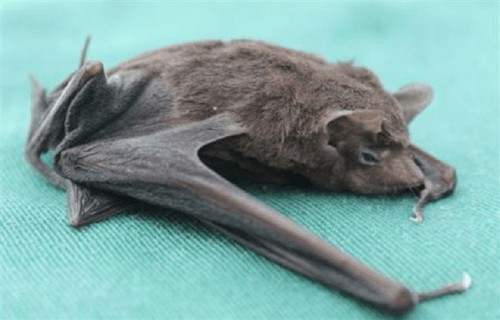
Seychelles Sheath-Tailed Bat Physical Description
Firstly, the extremely rare and highly threatened Seychelles Sheath-Tailed Bat stands out for several reasons. Some of them include factors other than sheer size. That holds true since the animal evolved as a comparatively diminutive member of its order.
In point of fact, an average head and body length for this specific species remains slight. This actually only totals between 2.1 – 2.5 in (55 – 65 mm). However, this tiny mammal does share one particular characteristic with many of its related species.
This occurs given that fact that the mammal displays a slight degree of the trait of sexual dimorphism. In its case, though, this occurs in the species in regards to weight. Males typically weigh about 10% less than the slightly thick-bodied females.
The fantastic Seychelles Sheath-Tailed Bat displays a dramatic pattern. This pattern consists of a deep reddish-brown to almost black, that predominates on the wings and back of the body. The underside of the body presents shades of gray or lighter shades of brown.
- Kingdom: Animalia
- Phylum: Chordata
- Class: Mammalia
- Order: Chiroptera
- Family: Emballonuridae
- Genus: Coleura
- Species: C. seychellensis
Seychelle’s Sheath-Tailed Bat Distribution, Habitat, and Ecology
The seriously imperiled Seychelles Sheath-Tailed Bat has potentially lost much of its original range. It now exists only in a tiny part of the world. More precisely, this consists of the Seychelles Islands, north of Madagascar in the Indian Ocean, near Africa.
Many scientists theorize that it also once existed in great numbers in the region. Now, however, it apparently only exists in a few limited locations, with specific conditions. This species also generally roosts in small caves and the cracks and crevices of rock faces.
In addition, it differs from most types of bats in a striking manner. The great majority of bats typically roost in enormous groupings. However, this animal forms harem colonies. These generally comprise a total of only 1 or 2 males, with multiple females.
Quite sadly, even more than most other endangered species, it appears to be especially vulnerable to habitat deterioration due to the influx of non-native plant species. This occurs since many of the native insect species cannot feed upon these invasive species of plants.
Therefore, its own numbers have greatly decreased. This, in turn, has the obvious effect of significantly reducing the available food source for the Seychelles Sheath-Tailed Bat. But this affects it more than others since the species has an entirely insectivorous diet.
4 Beguiling Bats
We sincerely hope that you have greatly enjoyed this article about 4 Beguiling Bats. Many people have strong, and often hostile, feelings about these magnificent mammals. However, whether you love them or hate them, nature designed them for a reason. Each of them fills an important ecological niche. Sadly, though, like many species around the world, some of them now find themselves in danger. It’s up to us to do all that we can to protect and preserve these 4 Beguiling Bats, and others, for our posterity.
Check out our other articles on 6 Extraordinary North American Reptiles, 7 Highly Unusual Lakes, Earth’s Many Astounding Beetles, Spectacular Dolphins Throughout Our World
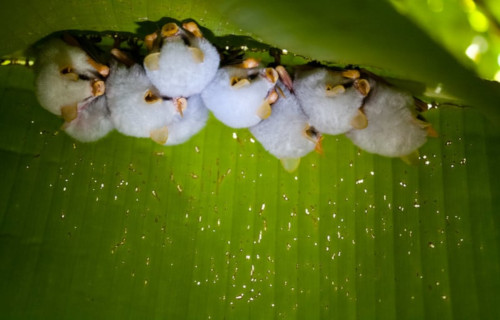
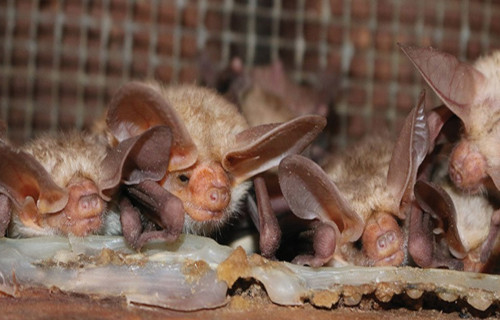
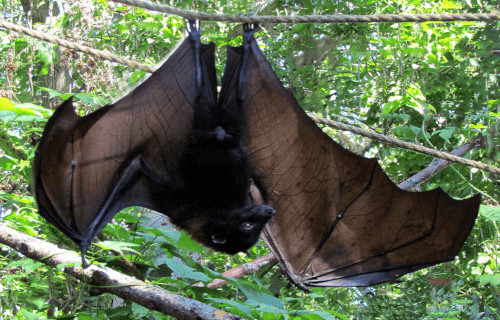
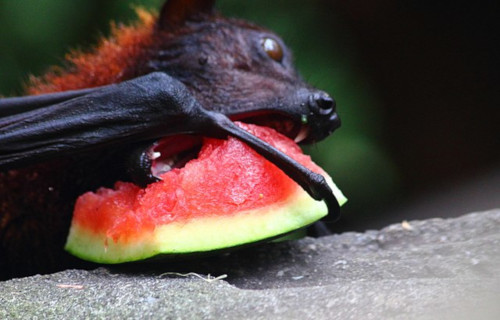

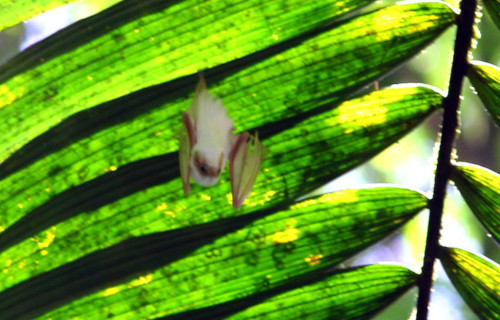
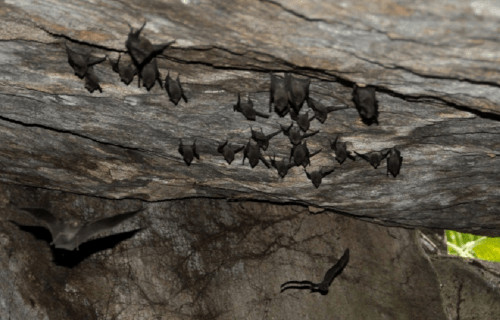









Leave a Reply